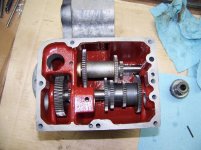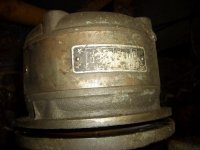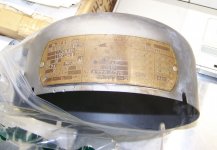I'm a bit confused. First, you note that the feed motor "has no cover and looks like a short motor (Pancake)", which suggests that it is the original axial air gap motor, but perhaps without the original cover? But then you state that the "Motor does not resemble Fig.24 on page 24", which is an illustration of the original axial air gap ("pancake") motor.
Can you post some photos of the motor and gear box?
What is the serial number of your Toolmaster?
What voltage are you supplying to the machine, and what are the numbers on the heaters for the powerfeed motor? What are the amperage ratings on the motor nameplate for the voltage(s) it is rated to operate with? Have you performed any checks on the motor before attempting to remove it, i.e. verified that the leads do (or do not) have resistance to ground? How many leads come out of the motor?
When the instructions state to tap "on the round head screws around motor," they refer to the slotted round head screws that hold the sheet metal cover (previously removed in the same step 2) onto the axial air gap motor, not the screws that hold the motor onto the mounting flange on the back of the gearbox housing.
I've had my Toolmaster 1-B powerfeed gearbox completely apart (there's a discussion and photos on here somewhere), and had the axial motor re-wound (a previous owner had it re-wound, but only brought out the 440v leads...), and the shaft just slides into the counterbore in the end of the worm drive shaft (174B in the M-2318 illustration). Mine is old enough that it did not have the nylon sleeve, so that must have been a later design change to allow for alignment issues between the shaft and motor.
If it were my Toolmaster (and once I'd verified the electrical items above), I'd remove the front cover of the gearbox, and watch what is happening to the worm drive shaft 174B as the motor is moved back and forth for what little bit of travel you can get without forcing it. It could be that the motor shaft and/or Woodruff key is too tight in the counterbore of the drive shaft 174B, and binding. If so, you might be able to remove the circlip (176B) and push the shaft and motor out of the housing, assuming that the shaft is not bound up on the inner races of bearings 143B and 175B. With only 5/16" movement of the motor, you won't be able to get circlip pliers onto 141B to allow the rear bearing 143B to come out of the housing with the shaft. You may have to remove circlip 141B once it's accessible, since the smaller front bearing 175B is not held in the housing and may want to come out with the shaft, i.e. it floats in the housing bore, probably to allow for expansion. Here's a photo showing the smooth bore for the small bearing in the upper left.








